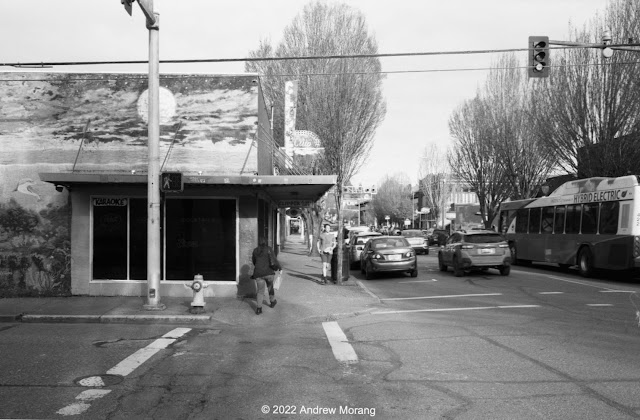Business took me to western Washington in 1995. A coworker and I looked at the beach at Ocean Shores, which faces the Pacific Ocean at the mouth of Grays Harbor. Southward sediment transport had built a wide beach against the north jetty. Developers were building condominiums on the beach. Was this a vulnerable location? Were there feasible escape routes if sirens warned of a tsunami? What would happen to the beach if the sediment transport shifted to moving north?
After the field trip, we had a few days to spend in Seattle. My coworker had never been to the city and was intrigued by the Space Needle. A fellow we met under the Needle generously offered us two free tickets for the elevator. It was a gorgeous sunny day, so, of course we took the lift to the viewing balcony.
 |
| Room with a view: Space Needle from the Mediterranean Inn (Fuji digital photograph taken with a Jupiter-8 lens) |
 |
| 2004 panorama of South Lake Union district from Eastlake Avenue E |
First, the general setting. This is a 2004 panoramic photograph of Queen Anne (the hill to the right), South Lake Union, Uptown, and Belltown districts (taken with a Hasselblad X-Pan camera). The Needle is the iconic tower built for the 1962 World's Fair. In the 1970s, when I was a student here, this area south of Lake Union was a commercial district of warehouses and manufacturing. By the early 2000s, it was transforming into condos, clubs, museums, and modern businesses. In the photograph above, the red building in the foreground is part of the Fred Hutchinson Cancer Center, one of the foremost cancer research institutes in the world. Click the picture to enlarge the scene and see the snowy Olympic Mountains in the distance.
 |
| Port of Seattle, view south from Space Needle |
 |
| Alaskan Way Viaduct before demolition (from Wikimedia, based on Open Street Maps) |
 |
| Union Bay with University of Washington Campus in the distance |
Turn to the northeast and look at the body of water. Union Bay is a freshwater bay in the center of Seattle. The Fremont Cut (to the left) lets boats reach Puget Sound via the Hiram M. Chittenden Locks. The Montlake Cut, beyond the I-5 bridge in the distance, gives access to Lake Washington. Museums, shipyards, houseboats, and seaplane companies line the shore of Lake Union. "Sleepless in Seattle" takes place in these houseboats. The Vashon Glacier excavated the lake about 12,000 years ago and sculpted most of the contemporary geomorphology in the Puget lowlands.
 |
| Lake Union view south |
This is Lake Union from the Gas Works Park, the site of a former coal gasification plant from the early 20th century. The Gas Works operated from 1873 to 1956, when natural gas from Canada supplanted the nasty and toxic gas plant. A landscape architect and University of Washington professor, Richard Haag, designed a plan to convert the site into a park, retaining some of the steel towers and tubes.
This ends our much too quick overview of Seattle. I want to look at my 1970s archives and see if there are more photographs from downtown.
By the way, if you want to see a really bad Elvis movie that features the Space Needle, watch "It Happened at the World's Fair." As TCM described it, "The Monorail and Space Needle are prominent as Mike (Elvis Presley) and friend Sue-Lin (Vicky Tiu) take in the sights". It is an utterly absurd plot, but Elvis sings. What more could you want in a movie?
This was article Sea 02















































